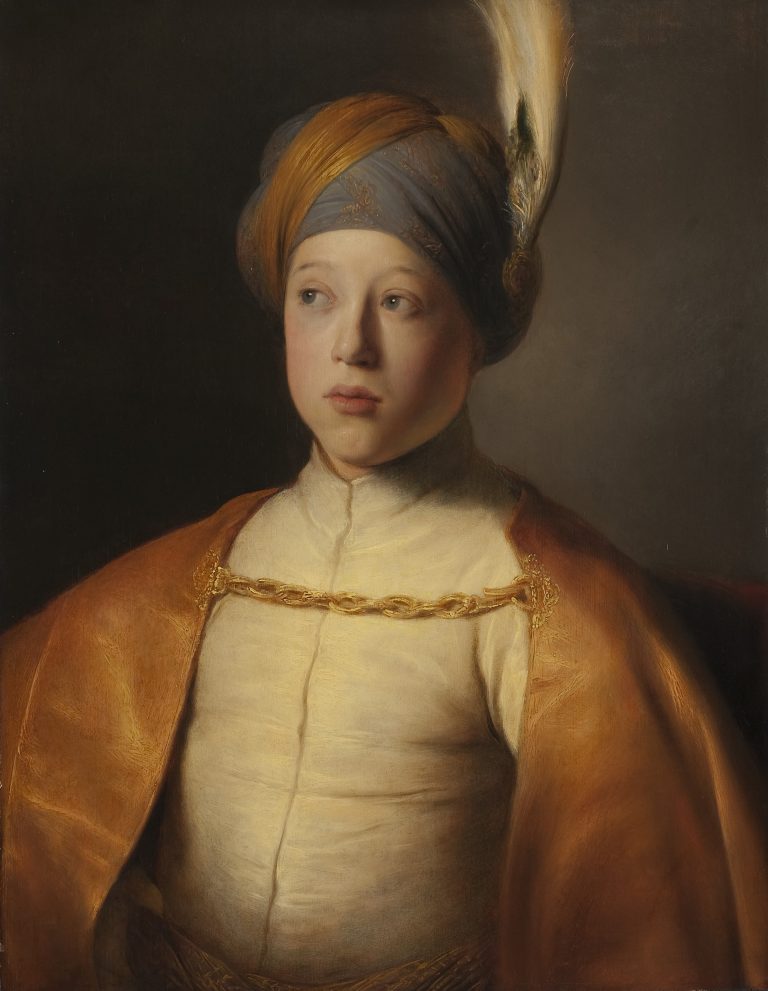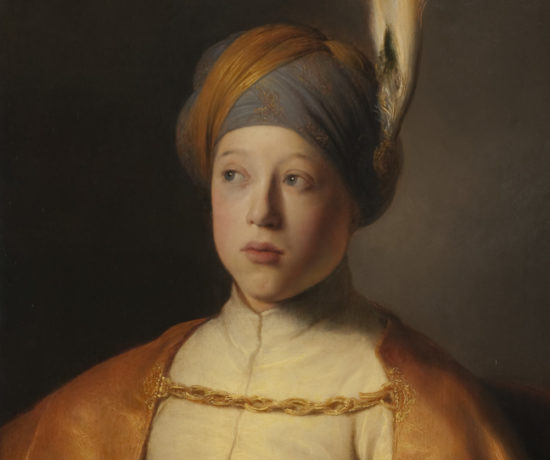In this beautiful and compelling image, Jan Lievens has depicted a smooth-faced boy exotically dressed in a golden cape attached with a chain clasp and a blue and gold turban festooned with the soaring plume of a bird of paradise.1 Light falling from the left illuminates the brilliant, shimmering fabrics of his wardrobe, a symphony of yellows, golds, and blues that bespeaks wealth and privilege. As exquisitely as Lievens has rendered the fabrics, even more remarkable is the sensitivity with which he has characterized the sitter’s expression. As the youth stands with one hand clasping his richly decorated cloth belt, he stares out to left with wide open eyes with a serious demeanor that conveys both dignity and inner resolve.2
The sitter looks like a Turkish or Persian character or a figure from a biblical story, but he is actually Prince Rupert of the Palatinate (1619–90), the youngest son of Frederick V (1596–1632), elector Palatinate, and Elizabeth Stuart (1596–1661). Lievens painted this portrait while Frederick, the nephew of Frederik Hendrik, stadholder of the United Provinces, and Elizabeth, daughter of James I, king of England, were living in exile in The Hague after losing their realm in 1619. Frederick had been named king of Bohemia in November 1619, but his Protestant forces were soon routed by those of Emperor Ferdinand II at the Battle of White Mountain, a key battle of the Thirty Years War. Since their reign only lasted one winter they were often referred to derisively as the Winter King and Winter Queen; nevertheless, they were warmly welcomed in The Hague and they maintained close relationships with Frederick Hendrick and his consort, Amalia van Solms.3
Lievens presumably received this commission through the recommendation of Constantijn Huygens (1596–1687), secretary to Frederick Hendrick, the prince of Orange and a scholar and connoisseur passionately interested in science, art, and music. In the late 1620s and early 1630s Huygens was instrumental in helping Lievens and Rembrandt van Rijn (1606–69) become court painters, not only for Frederick Hendrick and Amalia van Solms but also for Frederick and Elizabeth.4 Huygens was a great admirer of Lievens’s portraits, about which he wrote: “In painting the human countenance, he [Lievens] wreaks miracles,” and his artistic recommendations would have been eagerly followed by these courtly patrons.5 Portrait commissions from the Bohemian court were also appealing for Lievens because of his aspirations to become a court painter for Elizabeth’s brother, King Charles of England.
In the early 1630s Lievens and Rembrandt each painted portraits of the children of Frederick and Elizabeth. Rembrandt, with workshop participation, painted a portrait historié of Rupert and his tutor, possibly in the guise of the biblical figures Samuel and Eli (fig 1). In that painting Rupert wears an Oriental costume similar to that in the Leiden Collection painting.6 In 1631 Lievens painted a portrait historié of Rupert’s older brother, Charles Louis (1617–80), also in Oriental costume, and his tutor (J. Paul Getty Museum, Los Angeles). Lievens’s painting was presumably a pendant to Rembrandt’s portrait historié.7 Around 1631 Lievens also executed a formal portrait of Rupert.8
Meredith Hale proposed that the sitter of the Leiden Collection painting was Charles Louis, but because of the sitter’s young age and his close resemblance to the figure in Rembrandt’s portrait historié, a stronger argument can be made that he is Rupert.9 Rupert, who was twelve years old in 1631, had a straighter nose and narrower face than did Charles Louis, who was his elder by two years. These slight differences in the appearances of the princes became more prominent over time if one judges by double portrait Anthony van Dyck (1599–1640) painted of the two young men in 1637 (Musée du Louvre, Paris).10 There, the prominent jaw and sloping eyelids of the older but shorter Charles Louis have become quite distinctive features.
Rupert’s Oriental dress was part of a vogue for such costume in the Netherlands and England at the time, and Elizabeth must have specified this attire when she commissioned the portrait. Perhaps her interest was provoked by the physical appearance and manners of the members of the Persian embassy, notably Musa Beg, who fascinated the Dutch when he visited The Hague in 1626 on behalf of Shah Abbas to secure a trade pact with the Dutch.11 Lievens seems also to have been inspired by the figure of one of the Magi in a painting of the Adoration of the Magi by Peter Paul Rubens (1577–1640), a composition that would have been known to him through an engraving, dated 1621, by Lucas Vorstermans (1595–1675). Lievens had also used Rubens’s magus as the basis for Man in Oriental Costume (“Sultan Soliman”), 1629–30 (fig 2). This imposing painting was in the collection of Frederik Hendrik and therefore probably known to Elizabeth, which may explain why Lievens’s portrait of Rupert in Oriental costume follows very closely the pose and costume of the “sultan.”

